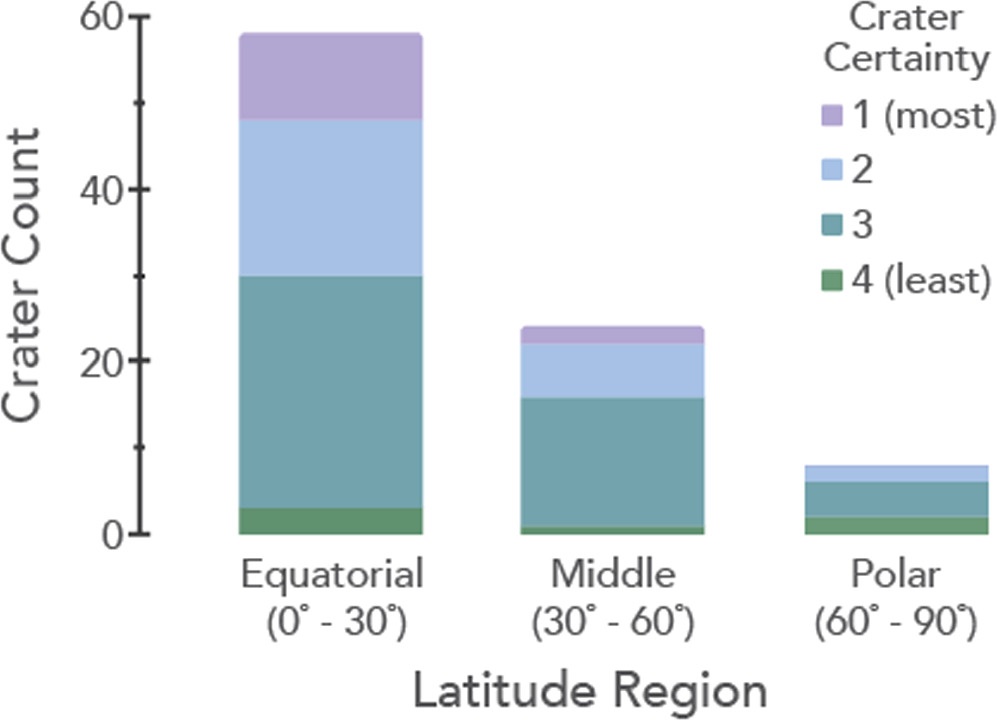Saturn’s moon, Titan, is an anomaly among moons. No other moons have surface liquids, and aside from Earth, it’s the only other Solar System object with liquids on its surface. However, since Titan is so cold, the liquids are hydrocarbons, not water. Titan’s water is all frozen into a surface layer of ice.
New research suggests that under the surface, Titan is hiding another anomaly: a thick crust of methane.
The evidence for the methane comes mostly from craters. Observations have found few confirmed impact craters on the frigid moon, and the ones that have been observed are hundreds of meters shallower than the same-sized craters on other moons. If Titan’s crust was rock, the craters should be much deeper.
The new research, published in The Planetary Science Journal, is titled “Rapid Impact Crater Relaxation Caused by an Insulating Methane Clathrate Crust on Titan.” Lauren Schurmeier, from the Hawai’i Institute of Geophysics and Planetology at the University of Hawai’i at Manoa, is the lead author.
Titan stands apart from other moons for multiple reasons. Unlike any other natural satellites in the Solar System, it has a thick atmosphere. Its atmosphere is about 50% more dense than Earth’s and extends about 600 km into space. A haze made of complex organic molecules called tholins gives the atmosphere its characteristic orange colour. The atmosphere is so thick that it blocks optical light, making Titan’s surface features nearly inscrutable.
The Cassini spacecraft has given us our best looks at Titan. It used radar and infrared instruments to see the moon’s surface. The small Huygens probe that went to Saturn with Cassini was released into Titan in 2005 to study the atmosphere and surface. It’s thanks to Huygens that we have our best images of Titan’s surface.
The new research suggests a link between Titan’s unusual atmosphere, its shallow surface craters, and a layer of methane in the moon’s crust. The methane keeps the underlying layer of ice convective by insulating it and helps impact craters rebound quickly and remain shallow.
There’s no consensus on how many craters Titan has because its surface is veiled behind its thick atmosphere, but there is some data on the craters.
The research centres on the fact that Titan displays few craters and that the ones we do see are shallow. This sets it apart from other moons.

“This was very surprising because, based on other moons, we expect to see many more impact craters on the surface and craters that are much deeper than what we observe on Titan,” said lead author Schurmeier. “We realized something unique to Titan must be making them become shallower and disappear relatively quickly.”
A handful of processes have been proposed to explain Titan’s diminishing craters. Liquid hydrocarbon rainfall, aeolian sand infill, and topographic relaxation induced by insulating sand infill have all been discussed. “Here, we propose an additional mechanism: topographic relaxation due to an insulating methane clathrate crustal layer in Titan’s upper ice shell,” the authors write.

There’s very little new information coming from Titan, so researchers have to work with what they have. To try to understand its shallow craters, the researchers built a computer model. They used it to try to understand how Titan’s topography might respond to impacts if a layer of methane clathrate was trapped under the surface. A clathrate is a substance where one type of molecule is trapped within a structure of molecules of another type. In this case, methane is trapped in water ice.
Methane’s insulating properties are key.
“Methane clathrate is stronger and more insulating than regular water ice,” said Schurmeier. “A clathrate crust insulates Titan’s interior, makes the water ice shell very warm and ductile, and implies that Titan’s ice shell is or was slowly connecting.”
With their model, they tested clathrate crusts that were 5, 10, 15, or 20 km thick. They used craters that were 40, 85, 100, and 120 km in diameter, each with two initial depths based on Ganymede’s crater diameters and depths. The result?
“We find that all clathrate crustal thicknesses result in rapid topographic relaxation despite Titan’s cold surface temperature,” the researchers write. “The 5 km thick clathrate crust can reproduce nearly all of the observed shallow depths, many in under 1000 yrs.”
They also found that a 10 km clathrate crust can reproduce Titan’s observed crater depths over geologic timescales. “If relaxation is the primary cause of the shallow craters, then the clathrate thickness is likely 5–10 km thick,” they write.
Across all simulations, most of the crater relaxation occurred in 1,000 years. “This finding suggests that thin clathrate crusts cause crater shallowing in a geological instant, similar to a fast-flowing terrestrial glacier,” the authors explain. It could certainly explain why none of Titan’s craters are deep.
The researchers point out a couple of caveats, though. They assumed that Titan’s initial craters had depths similar to Ganymede’s. They could’ve formed at different depths and shapes. Their model also didn’t include heat generated by the impact itself or account for an impact-triggered discontinuity in the methane clathrate layer. “These thermal and dynamic changes might alter the morphological evolution of the crater,” they write.

This research adds to Titan’s mystery and our fascination with the unusual moon. It also adds another element to comparisons with Earth. Earth and Titan both have surface liquid and are the only two objects in the Solar System that do. Earth also has methane clathrates in its polar regions.
“Titan is a natural laboratory to study how the greenhouse gas methane warms and cycles through the atmosphere,” said Schurmeier. “Earth’s methane clathrate hydrates, found in the permafrost of Siberia and below the arctic seafloor, are currently destabilizing and releasing methane. So, lessons from Titan can provide important insights into processes happening on Earth.”
In the end, their results are clear: “We conclude that if crater relaxation is the primary cause of Titan’s unexpectedly shallow craters, then the clathrate crust is 5–10 km thick,” the authors write.

